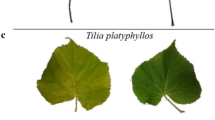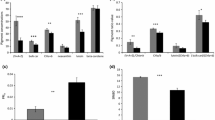Abstract
Key message
Subarctic plants in summer (subjected to continuous light) showed photosynthetic pigment contents mainly driven by PPFD (unrelated to day/night cycles) and a xanthophyll cycle responsiveness to PPFD exacerbated during night-times.
Abstract
Composition and content of photosynthetic pigments is finely tuned by plants according to a subtle equilibrium between the absorbed and used energy by the photosynthetic apparatus. Subarctic and Arctic plants are subjected to extended periods of continuous light during summer. This condition represents a unique natural scenario to study the influence of light on pigment regulation and the presence of diurnal patterns potentially governed by circadian rhythms. Here, we examined the modulation of the photosynthetic apparatus in three naturally co-occurring woody species: mountain birch (Betula pubescens ssp. czerepanovii), alpine bearberry (Arctostaphylos alpina) and Scots pine (Pinus sylvestris) around the summer solstice, at 67 °N latitude. Plants were continuously exposed to solar radiation during the 3-day study period, although PPFD fluctuated, being lower during night-times. Photochemical efficiencies for a given PPFD were similar during daytime and night-time for the three species. In Scots pine, for a given PPFD, net assimilation was slightly higher during daytime than during night-time. Overall, the dynamism in pigment content was mainly driven by PPFD, and was generally unrelated to day/night cycles. Weak indications of potential circadian regulation were found over a few pigments only. Interestingly, the xanthophyll cycle was active at any time of the day in the three species but its responsiveness to PPFD was exacerbated during night-times. This was particularly evident for bearberry, which maintained a highly de-epoxidised state even at night-times. The results could indicate an incomplete acclimation to a 24-h photoperiod for these species, which have colonised subarctic latitudes only recently.









Similar content being viewed by others
References
Atherton J, Olascoaga B, Alonso L, Porcar-Castell A (2017) Spatial variation of leaf optical properties in a boreal forest is influenced by species and light environment. Front Plant Sci. https://doi.org/10.3389/fpls.2017.00309
Audran C, Borel C, Frey A, Sotta B, Meyer C, Simonneau T, Marion-Poll A (1998) Expression studies of the zeaxanthin epoxidase gene in Nicotiana plumbaginifolia. Plant Physiol 118:1021–1028
Bell-Pedersen D, Cassone VM, Earnest DJ, Golden SS, Hardin PE, Thomas TL, Zoran MJ (2005) Circadian rhythms from multiple oscillators: lessons from diverse organisms. Nat Rev Genet 6:544–556
Björkman O, Demmig B (1987) Photon yield of O2 evolution and chlorophyll fluorescence characteristics at 77 K among vascular plants of diverse origins. Planta 170:489–504
Boelman NT, Magney TS, Logan BA, Griffin KL, Eitel JUH, Greaves H, Prager CM, Vierling LA (2016) Spectral determination of concentrations of functionally diverse pigments in increasingly complex arctic tundra canopies. Oecologia 182:85–97
Caldeira CF, Jeanguenin L, Chaumont F, Tardieu F (2014) Circadian rhythms of hydraulic conductance and growth are enhanced by drought and improve plant performance. Nat Commun 15:5365
Covington MF, Maloof JN, Straume M, Kay SA, Harmer SL (2008) Global transcriptome analysis reveals circadian regulation of key pathways in plant growth and development. Genome Biol 9:R130
Dakhiya Y, Hussien D, Fridman E, Kiflawi M, Green R (2017) Correlations between circadian rhythms and growth in challenging environments. Plant Physiol 173:1724–1734
Dall’Osto L, Cazzaniga S, North H, Marion-Poll A, Bassi R (2007) The Arabidopsis aba4-1 mutant reveals a specific function for neoxanthin in protection against photooxidative stress. Plant Cell 19:1048–1064
Demmig-Adams B, Adams WW (1996) The role of xanthophyll cycle carotenoids in the protection of photosynthesis. Trends Biochem Sci 1:21–26
Esteban R, Barrutia O, Artetxe U, Fernández-Marín B, Hernández A, García-Plazaola JI (2015) Internal and external factors affecting photosynthetic pigment composition in plants: a meta-analytic approach. New Phytol 206:268–280
Fernàndez-Martínez J, Fleck I (2016) Photosynthetic limitation of several representative subalpine species in the Catalan Pyrenees in summer. Plant Biol 18:638–648
Frazer GW, Canham CD, Lertzman KP (1999) Gap Light Analyzer (GLA), version 2.0: imaging software to extract canopy structure and gap light transmission indices from true-colour fisheye photographs, users manual and program documentation. Copyright © 1999. Simon Fraser University, Burnaby
Fukushima A, Kusano M, Nakamichi N, Kobayasho M, Hayashi N, Sakakibara H, Mizuno T, Saito K (2009) Impact of clock-associated Arabidopsis pseudo-response regulators in metabolic coordination. Proc Natl Acad Sci USA 106:7251–7256
García-Plazaola JI, Becerril JM (1999) A rapid HPLC method to measure lipophilic antioxidants in stressed plants: simultaneous determination of carotenoids and tocopherols. Phytochem Anal 10:307–313
García-Plazaola JI, Fernández-Marín B, Ferrio JP, Alday JG, Hoch G, Landais D, Milcu A, Tissue DT, Voltas J, Gessler A, Roy J, Resco de Dios V (2017) Endogenous circadian rhythms in pigment composition induce changes in photochemical efficiency in plant canopies. Plant Cell Environ. https://doi.org/10.1111/pce.12909
Havaux M, García-Plazaola JI (2014) Beyond non-photochemical fluorescence quenching: the overlapping antioxidant functions of zeaxanthin and tocopherols. In: Demmig-Adams B, Garab G, Adams W, Govindjee (eds) Non-photochemical quenching and energy dissipation in plants, algae and cyanobacteria. Springer, Dordrecht, pp 583–603
Havaux M, Dall’Osto L, Bassi R (2007) Zeaxanthin has enhanced antioxidant capacity with respect to all other xanthophylls in Arabidopsis leaves and functions independent of binding to PSII antennae. Plant Physiol 145:1506–1520
Kolari P, Lappalainen HK, Hänninen H, Hari P (2007) Relationship between temperature and the seasonal course of photosynthesis in Scots pine at northern timberline and in southern boreal zone. Tellus B 59:542–552
Kouril R, Wientjes E, Bultema JB, Croce R, Boekema EJ (2013) High-light vs. low-light: effect of light acclimation on photosystem II composition and organization in Arabidopsis thaliana. Biochim Biophys Acta 1827:411–419
Kromdijk J, Głowacka K, Leonelli L, Gabilly ST, Iwai M, Niyogi KK, Long SP (2016) Improving photosynthesis and crop productivity by accelerating recovery from photoprotection. Science 354:857–861
Litthauer S, Battle MW, Lawson T, Jones MA (2015) Phototropins maintain robust circadian oscillation of PSII operating efficiency under blue light. Plant J 83:1034–1045
McClung CR (2006) Plant circadian rhythms. Plant Cell 18: 792–803
Míguez F, Fernández-Marín B, Becerril JM, García-Plazaola JI (2015) Activation of photoprotective winter photoinhibition in plants from different environments: a literature compilation and meta-analysis. Physiol Plant 155:414–423
Míguez F, Fernández-Marín B, Becerril JM, García-Plazaola JI (2017) Diversity of winter photoinhibitory responses: a case study in co-occurring lichens, mosses, herbs and woody plants from subalpine environments. Physiol Plant. https://doi.org/10.1111/ppl.12551
Morosinotto T, Bassi R (2012) Assembly of light harvesting pigment-protein complexes in photosynthetic eukaryotes. In: Eaton-Rye JJ, Tripathy BC, Sharkey TD (eds) Photosynthesis: plastid biology. Energy conversion and carbon assimilation. Advances in photosynthesis and respiration, vol 34. Springer, London, pp 113–126
Pan WJ, Wang X, Deng YR, Li JH, Chen W, Chiang JY, Yang JB, Zheng L (2015) Nondestructive and intuitive determination of circadian chlorophyll rhythms in soybean leaves using multispectral imaging. Sci Rep 5:11108
Patankar R, Mortazavi B, Oberbauer SF, Starr G (2013) Diurnal patterns of gas-exchange and metabolic pools in tundra plants during three phases of the arctic growing season. Ecol Evol 3:375–388
Pedersen B (1990) Distributional patterns of vascular plants in Fennoscandia: a numerical approach. Nord J Bot 10:163–189
Porcar-Castell A, Tyystjärvi E, Atherton J, van der Tol C, Flexas J, Pfündel EE, Moreno J, Frankenberg C, Berry JA (2014) Linking chlorophyll a fluorescence to photosynthesis for remote sensing applications: mechanisms and challenges. J Exp Bot 15:4065–4095
Resco de Dios V, Goulden ML, Ogle K, Richardson AD, Hollinger DY, Davidson EA, Alday JG, Barron-Gafford GA, Carrara A, Kowalski AS, Oechel WC. Reverter BR, Scott RL, Varner RK, Moreno JM (2012) Endogenous circadian regulation of carbon dioxide exchange in terrestrial ecosystems. Glob Change Biol 18:1956–1970
Resco de Dios V, Diaz-Sierra R, Goulden ML, Barton CV, Boer MM, Gessler A, Ferrio JP, Pfautsch S, Tissue DT (2013) Woody clockworks: circadian regulation of night-time water use in Eucalyptus globulus. New Phytol 200:743–752
Shmakova NY, Markovskayab EF (2010) Photosynthetic pigments of plants and lichens inhabiting arctic tundra of West Spitsbergen. Russ J Plant Physiol 57:764–769
Velez-Ramirez AI, van Ieperen W, Vreugdenhil D, Millenaar FM (2011) Plants under continuous light. Trends Plant Sci 16:310–318
Velez-Ramirez AI, van Ieperen W, Vreugdenhil D, Pieter MJA, van Poppel MJA, Heuvelink E, Millenaar FM (2014) A single locus confers tolerance to continuous light and allows substantial yield increase in tomato. Nat Commun 5:4549
Zhao W, Wang S, Li X, Huang H, Sui X, Zhang Z (2012) Molecular cloning and characterization of the light-regulation and circadian-rhythm of the VDE gene promoter from Zingiber officinale. Plant Cell Rep 31:1381–1392
Funding
Basque Government (UPV/EHU IT-1018-16); Spanish Ministry of Economy and Competitiveness (MINECO) and the ERDF (FEDER) (CTM2014-53902-C2-2-P) to JIGP and BFM; and “Juan de la Cierva-Incorporation” Fellowship IJCI-2014-22489 to BFM; Finnish Academy (272041 and 293443); Funds of the University of Helsinki (490116).
Author information
Authors and Affiliations
Corresponding author
Ethics declarations
Conflict of interest
The authors of this manuscript declare no conflict of interest.
Additional information
Communicated by A. Gessler.
Electronic supplementary material
Below is the link to the electronic supplementary material.
Rights and permissions
About this article
Cite this article
Fernández-Marín, B., Atherton, J., Olascoaga, B. et al. When the sun never sets: daily changes in pigment composition in three subarctic woody plants during the summer solstice. Trees 32, 615–630 (2018). https://doi.org/10.1007/s00468-018-1660-9
Received:
Accepted:
Published:
Issue Date:
DOI: https://doi.org/10.1007/s00468-018-1660-9




